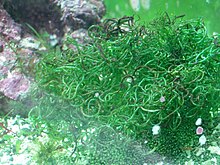Chaetomorpha: Difference between revisions
Ashorocetus (talk | contribs) |
Rescuing 2 sources and tagging 0 as dead. #IABot (v1.2.7.1) |
||
| Line 42: | Line 42: | ||
{{Taxonomic links|NCBI_taxID=3185|taxoname=Chaetomorpha}} |
{{Taxonomic links|NCBI_taxID=3185|taxoname=Chaetomorpha}} |
||
* [http://www.algaebase.org/search/genus/ AlgaeBase] |
* [http://www.algaebase.org/search/genus/ AlgaeBase] |
||
* [http://www.algaterra.org/ATDB/Names/NamesMain.cfm AlgaTerra database] |
* [https://web.archive.org/web/20070928163719/http://www.algaterra.org/ATDB/Names/NamesMain.cfm AlgaTerra database] |
||
* [http://ravenel.si.edu/botany/ing/ingForm.cfm Index Nominum Genericorum] |
* [https://web.archive.org/web/20070819165523/http://ravenel.si.edu/botany/ing/ingForm.cfm Index Nominum Genericorum] |
||
[[Category:Cladophorales genera]] |
[[Category:Cladophorales genera]] |
||
Revision as of 23:54, 18 November 2016
This article needs additional citations for verification. (December 2014) |
| Chaetomorpha | |
|---|---|

| |
| Scientific classification | |
| Domain: | |
| Kingdom: | |
| Phylum: | |
| Class: | |
| Order: | |
| Family: | |
| Genus: | Chaetomorpha
|
| Species | |
In taxonomy, Chaetomorpha, also called Chaeto for short, is a genus of green algae, specifically of the Cladophoraceae.[1]The species grow as tufts or solitary unbranched filaments attached by a basal cell or unattached in a mass of filaments.
Species recorded include: Chaetomorpha melagonium, Chaetomorpha linum, Chaetomorpha mediterranea and Chaetomorpha linum.[2]
Aquarium hobby usage
Chaetomorpha is especially common in saltwater aquariums because it can be used for removal of nutrients, especially nitrates. Aquarists will commonly house this alga, perhaps with others, in a refugium. Once it has grown to a significant mass, a chunk of the algae is removed to be thrown out or donated to another aquarist, taking the nutrients it has absorbed out of the system. Chaetomorpha is preferred over other macroalgae such as Caulerpa because it is less likely than Caulerpa to undergo sexual reproduction in the aquarium. It is also easy to remove because it will not attach to rocks or substrates. In a study run by Casey Campbell, it was shown that coal bed methane is filtered by Chaetomoropha. In addition to nutrient export, Chaetomorpha is known to host beneficial amphipods which can subsequently be used as a food source for corals and animals that may reside within the aquarium.
Chaetomorpha can, alternatively, be replaced by an algae scrubber.
References
- ^ See the NCBI webpage on Chaetomorpha. Data extracted from the "NCBI taxonomy resources". National Center for Biotechnology Information. Retrieved 2007-03-19.
- ^ Burrows, E.M. 1991. Seaweeds of the British Isles Volume 2 Chlorophyta. Natural History Museum, London. ISBN 0-565-00981-8
